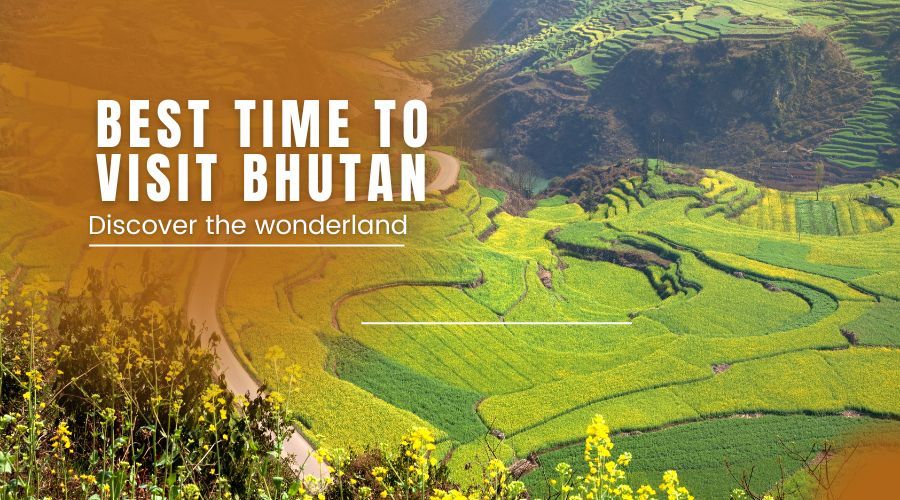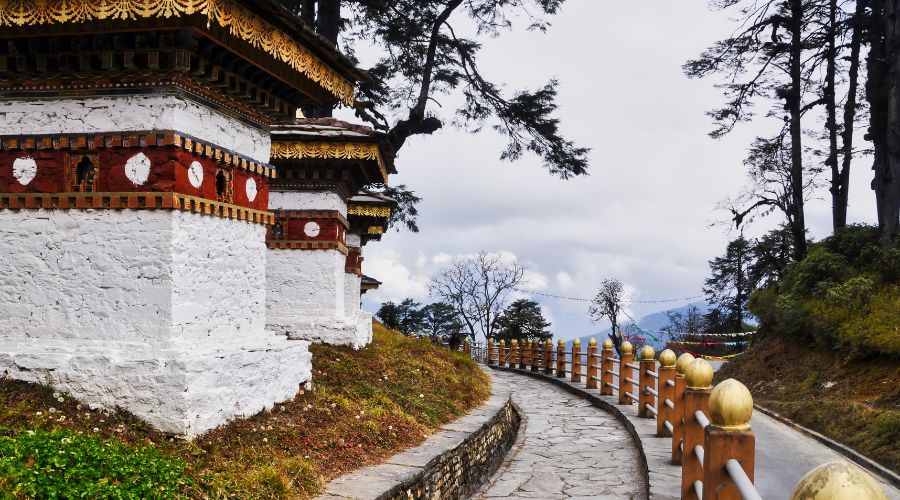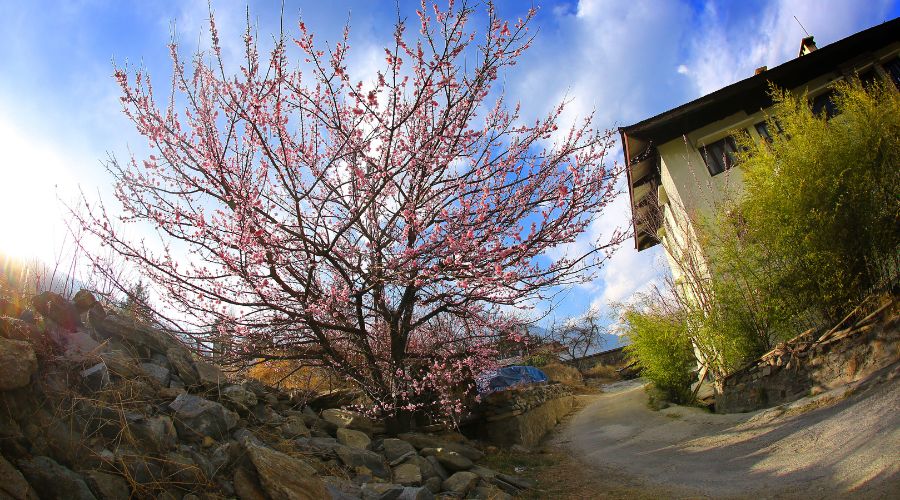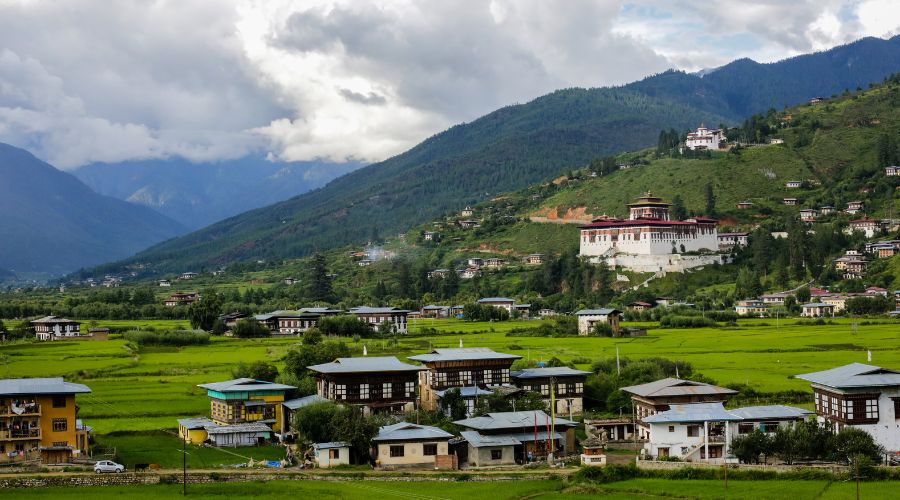
When is the best time to visit Bhutan?

When is the best time to visit Bhutan?
swotah travel
839
20, 08 2023
The best time to visit Bhutan is during the months of October to December and then again from March to May. The weather is generally pleasant during these periods, with clear skies and mild temperatures. October to December offers the beauty of autumn foliage and various cultural festivals, while March to May showcases the vibrant spring blooms and pleasant trekking conditions. It's advisable to avoid the monsoon season from June to August due to heavy rainfall that can disrupt travel plans.
Introduction
Bhutan is a landlocked country that shares its border with India and China. It is located in central Asia. Its geography is typically categorized into mountains, deep valleys, and plateaus. Bhutan is the only carbon-negative ( meaning it absorbs more amount of carbon dioxide than the amount that is produced) country on the face of the Earth. 70% of Bhutan’s land is masked by forest. It has a rule in its constitution to have 60% of the nation’s land needs to be covered by forest at all times. This makes Bhutan one of the least polluted countries in the world.
The main religion of Bhutan is Buddhism. Around 75% of the total population here follows Buddhism, and the left 25% follow Hinduism. It has diverse ethnic groups, cultures, and festivals. The main inhabitants of the ethnic groups are Naglop. Naglop are the early settlers of Bhutan, they are also known as “Bhote”. Their native language is Dzongkha. It is the mother tongue (national language) of Bhutan. Other ethnic groups here are Sharchop, Lhotsampa (Nepalese people: Tamang, Gurung, Rai, and Limbu), Tibetans, etc.

Bhutan is rich in snow-capped mountains. There are 45 known mountains located here. The tallest mountain in Bhutan is Gangkhar Puensum. It is 7570 m / 234836 ft tall. This is the tallest mountain in the world yet to be climbed. Some of the majestic mountains in Bhutan are Chomolhari Kang 7046 m / 23117 ft, Jitchu Drake 6714 m / 22028 ft, Tongshangjiabu 7207 m / 23645 ft, Kula Kangri 7538 m / 24731 ft, Jomolhari 7326 m / 24035 ft, Liankang Kangri 7535 m / 24721 ft, Kangphu Kang 7204 m / 23635 ft, Masang Kang 7194 m / 23602 ft, etc.
Bhutan is on the list of every trekker and traveler due to its beauty, nature, mountains, landscapes, cultures, food, safety, and many more aspects. So, when is the right time to explore this stunning country?
What is the best time of the year to visit Bhutan?
Bhutan has four different seasons, like every nation in the world. The Spring season (March, April, and May), the Summer / Monsoon season ( June, July, and August), the Autumn season (September, October, and November), and the Winter season ( December, January, and February). The best time to enjoy Bhutan is the Spring season and the Autumn / Fall season. Let’s dive into the details.
The Spring season:
Step into spring, the second best time for a Bhutan trip. The weather across the country is just right for strolls and enjoyment. The temperature changes with altitude. Higher places are colder, while lower lands are warmer. Nature's beauty and season's play come together splendidly.
In the lower valleys and the plain region of Bhutan during Spring, the coldest temperature is around 15 degrees Celsius / 59 degrees Fahrenheit, and the hottest is around 25 degrees Celsius / 77 degrees Fahrenheit. Similarly, in the mountainous regions, the coldest temperature during the Spring is nearly 10 degrees Celsius / 50 degrees Fahrenheit and the hottest is around 15 degrees Celsius / 59 degrees Fahrenheit.

Spring season is perfect to admire the beauty of unique flowers in Bhutan as they bloom. It is the ideal time for sightseeing the places around as the weather is clear and views are unobstructed by clouds, rain, etc. The weather is nice and clear. One of the festivals, the Bhutanese named Paro Tsechu is celebrated in the Spring season. Paro Teschu festival is celebrated on the tenth day of the month according to the lunar calendar. It is celebrated by dancing, singing, and performing different skill sets in colourful clothes. Typically monks perform different kinds of dances with their faces masked, laymen perform different athletic movements while being masked and groups of women sing various songs with minimal dances So, traveling around this season not only gives you the best of nature but also lets you take part in their festival.
The Autumn / Fall season
This is the most preferred time to visit Bhutan by most trekkers. Autumn has mild weather, making it easy for people from different places to adapt well. The skies are as clear as they can get. Months of this season offer the perfect environment for sightseeing and enjoying the panoramic views. The temperature range during Autumn is similar to that of Spring. In the highlands near the Himalayas, it ranges from around 9 degrees Celsius / 48.2 degrees Fahrenheit to 23 degrees Celsius / 73.4 degrees Fahrenheit, and in the plain, it is around 19 degrees Celsius / 66.2 degrees Fahrenheit to 25 degrees Celsius / 77 degrees Fahrenheit.
The Autumn season has a lot of festivals in store for you to amaze namely Thimpu Tsechu ( this festival is celebrated for three days where people gather and celebrate together performing traditional dances. It is believed the tantric readings during this festival heal all the misfortunes and conflicts and prevail in happiness and peace), Jambey Lhakhang Drup ( it is a 4 days festival celebrated in Bhumtang valley to show respect and celebrate the establishment of Jambay Lhakhang temple. At midnight, a naked dance is performed that other people are prohibited to see. Anyway, you can see cham dance and enjoy various fairs).
The Summer / Monsoon season
Bhutan offers a delightful summer escape for travellers. Despite rumours of cloud-covered skies dampening trekking plans, this is hardly the norm. The monsoon season here doesn't unleash relentless downpours; rather, it brings about gentle showers every other day. The ambiance remains refreshingly cool without dipping into chilly territory, making it ideal for leisurely strolls. Temperatures during this time range between 25 degrees Celsius / 77 degrees Fahrenheit and 31 degrees Celsius / 87.8 degrees Fahrenheit. The landscape comes alive with picturesque vistas of mountains, forests, blossoms, and expansive fields.

Photo: Paro Valley in Summer
Bhutan maintains its tranquil charm, unaffected by overwhelming tourist crowds. The summer months offer an ideal window for those seeking solace away from bustling masses. Notably, the Haa festival graces this season with its presence. Celebrating the Bhutanese way of life,the Haa festival transforms into a grand extravaganza – a jubilant fair where people unite in dance, song, local gastronomy, drinks, and revelry. A variety of sports such as archery, darts, and horse riding further add to the festivities. The Haa festival presents tourists a golden opportunity to immerse themselves in the Bhutanese lifestyle.
For prospective travellers, planning a trip during this period entails packing attire attuned to the weather, ensuring protection from even the lightest drizzles. It's also advisable to include some warm clothing, as rainfall can usher in a coolness that might otherwise lead to discomfort or illness.
The Winter season
Traveling in the winter season has a bit more problems than in other seasons. The temperature gets very low, causing difficulties in moving around. The coldest temperature is around -5 degrees Celsius / 23 degrees Fahrenheit and the highest is around 11 degrees Celsius / 51.8 degrees Fahrenheit to 15 degrees Celsius /59 degrees Fahrenheit. There are snowfalls that can block paths/roads, making it hard for the trip.
Other than these, the snowfall makes Bhutan even more beautiful. This is the time when the Punakha Dromche festival is celebrated. This festival is celebrated to rejoice in the victory over the Tibetans during the 17th century. People wear masks and traditional costumes and then perform different dances and songs. Everyone is allowed to be part of this festival.
Note: if you have your mind made to visit Bhutan in Winter, then pack really warm clothes, check the weather conditions before moving from one place to another, and carry some over the counter medicines to fight the common cold.
Also Read: How much would it cost to visit Bhutan?
Discovering the Tiger's Nest monastery in Bhutan
What are the must-visit places in Bhutan?
Now that we know what is the ideal time to visit Bhutan according to your expectations from the trip, let us take you through some places here that you would not want to miss.
-
Thimpu: Thimpu is the capital of Bhutan. This is the most happening place in the entire country. Thimpu is the ideal place to get a taste of the Bhutanese culture and people.
-
Trongsa Dzong: Trongsa Dzong is the largest fortress in Bhutan of Dzong architecture. It was built in a very calculated way to connect the path from east to west. The Trongsa Dzong is the headquarter of the Trongsa district.
-
National Museum of Bhutan: The national museum was built in 1968. It is located in western Bhutan’s famous town known as Paro. This museum reflects the cultures, arts, and history beautifully. If you want to learn about Bhutan's roots, then a visit here is a must.
-
Phobjikha Valley: This valley ki located in central Bhutan. It is rich in cultural, floral, and faunal diversity. The valley has the letter “U” shape. The Gangten monastery is located in this valley. It shelters the black-necked crane. This monastery draws the history back to the beginning of the Vajrayana tradition.
-
Haa Valley: Haa Valley is the perfect place in Bhutan to observe its scenic views and mountains. It links three different districts, namely Paro, Chhukha, and Samtse. Many nomadic herders (a kind of animal farming in which the farmers move from one place to another with their animals and produce animal products like wool, cheese, ghee, meat, etc.) live here. The Chele La Pass (3988 m / 13083 ft) situated in the Haa Valley flaunts the best view of the majestic Himalayas.
-
Bumthang Valley: The Bhumtang Valley is one of Bhutan's most sacred places with historical and spiritual values. It has many monasteries and temples like Jambay Lhakhang Temple, Kurjey Monastery, Tamshing Monastery, Jakar Dzong, Ura Temple, and Kenchosum Lhakhang. This valley is home to Ogen Choling Palace Museum and the famous Jakar Dzong.
NEWSLETTER SIGNUP
Sign up to receive our trip ideas and travel offers!
Get updates and Exclusive Offers up to 20% Discount









